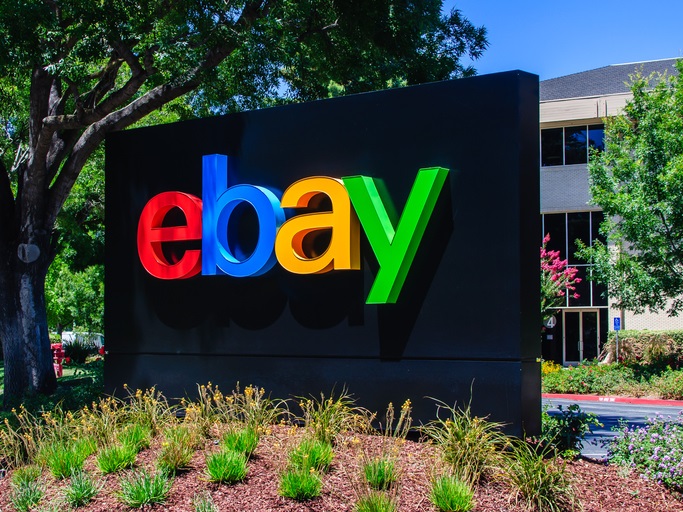Stockwatch: has eBay now reached critical mass?
The e-commerce platform is enjoying an upturn, but its stock is still modestly rated.
5th February 2021 12:21
by Edmond Jackson from interactive investor
The e-commerce platform is enjoying an upturn, but its stock is still modestly rated.

Shares in the $44 billion (£32 billion) e-commerce group eBay Inc (NASDAQ:EBAY) are up from $58 to $61 after reporting very strong results for the fourth quarter of 2020 – smashing revenue and earnings estimates even relative to October’s guidance.
Like-for-like revenue has soared 28% to $2.9 billion, 7% better than expectations, with net income up 52% to $845 million and earnings per share a whopping 75% to $1.21 – versus last October’s guidance for 61 cents and recent consensus for 64 cents.
Operating cash flow was $883 million and free cash flow $175 million, supporting a 13% rise in the quarterly dividend pay-out to 18 cents a share.
Mind how profit/earnings have benefited from a net interest contribution that is 39% of pre-tax profit (see summary income statements).
eBay’s strong cash generation over time has led to a $4 billion cash pile where returns from ‘near-cash investments’ have surged. These results also reflect a double whammy of the run-up to Christmas and people having spare cash from curtailed spending on transport and eating out.
- ii view: Bezos steps down as Amazon sales blast past $100bn
- ii view: Alibaba cloud profit battles foggy regulatory outlook
But while $1.7 trillion Amazon (NASDAQ:AMZN) trades on an historic price-to-earnings (PE) ratio of around 100x, and 50x on a forward basis, I cannot resist noting how eBay’s earnings per share has advanced 75% versus a sub-9x historic PE.
It means the most perversely low, price earnings-to-growth (or PEG) ratio I have ever seen for an established growth company - of 0.1. In particular, one nowadays with global mass-market reach. You will struggle to find any UK-listed growth stock on a PEG less than the benchmark 1.0, and Alibaba (NYSE:BABA) is on an astonishing 47.4.
Matured into a well-diversified online retailer
People’s impression of eBay can remain quite stubbornly of a second-hand bazaar, somewhat akin to the free British site Gumtree, which offers classified ads for household items.
But I have noticed that on a range of regularly bought items the leading best price can be found via eBay. Often the suppliers are genuine British companies.
It remains a moot point whether smaller private companies benefit more or less from an association with eBay, where they may cede margin but gain revenue if successful. Yet eBay’s declaring its gross merchandise volume rose 21% to $26.6 billion underlines how it is advancing.
This was helped by an authenticity guarantee for luxury watches, training shoes and refurbished gifts over the key Christmas buying period

For example, last year the average customer who spent more than $100 on sneakers went on to spend more than $2,500 on eBay, 80% of which was spread over other products.
Hence eBay’s current drive to reach younger people, for instance via social media platform TikTok, and continued enhancements to its app, which accounts for nearly half of merchandising revenue.
The number of annual active buyers is up 7% to 185 million, with younger customers targeted. From a shopping perspective, I regard eBay as up there with Amazon and Alibaba – as a retailing forum, Google directs you towards for searched items.
eBay’s partnering with the NHS to deliver more than a billion PPE items to in excess of 45,000 social care workers shows it is a vital mainstream distributor.
- Despite crackdown fears, Chinese tech ETFs race ahead in 2021
- Want to buy and sell international shares? It’s easy to do. Here’s how
I am unsurprised how such marketing strengths are translating into bumper financial results. The third quarter of 2020 saw a 25% like-for-like advance in revenue, helped by a 5% rise in active buyers and gross merchandise revenue up 22%. Net profit soared 114%, helped by interest payments being eliminated.
For the full-year 2020, revenue rose 19% to $10.3 billion, slightly ahead of consensus for $10.27 billion. Gross merchandise volume is up 17% to $100 billion and annual active buyers by 7% to 185 million.
Yes, an extent of this is due to more people being at home, reverting to online retail during the pandemic. But I suspect a good element of this shift will stick. Once you establish eBay as a means of product sourcing, it stays.
This is shown by guidance for the current first quarter of 2021, of 35% to 37% like-for-like revenue growth close to $3 billion. In other words, this repeats the record latest quarter despite the New Year more typically being a retailing quiet period.
A target for activist investors to demand higher payouts
On a conservative dividend approach, eBay’s 1.1% prospective yield will appear unexciting to British investors used to big established retailers yielding around 5%. Although UK-listed Ocado (LSE:OCDO) is quite like Amazon and Alibaba, in the sense of never having paid out and constituting a technology proposition also, that puts these stocks firmly in the capital growth league.
Given eBay’s cash pile represents nearly 10% of market capitalisation, it cannot be too long until either the board re-rates the payout or shareholders push for this.
Two years ago, Elliott Management and Starboard Value (owning about 5%) pushed for fresh appointments to the board and to spin off several operations, which led to other funds buying and co-operation agreement being signed. There was also a strategic review and streamlining of operations.
Going back to 2014 and 2015, US investor Carl Icahn speared a demand for eBay to spin off its lucrative PayPal operation, which has resulted in PayPal Holdings (NASDAQ:PYPL) being capitalised near $320 billion.
Given the way he rattled Apple’s cage towards paying out some of its cash pile, that could be judged appropriate here.
There seems little point in eBay potentially ‘diworsifying’ with big acquisitions. And, while it will always need to maintain an aspect of IT spend to keep its platforms advanced, “product development” costs are only around 20% of total operating expenses.
Not to suggest eBay is poised to compete with the kind of yields we expect from retailers, but I would pencil in improved payout – indeed the possibility of a special dividend.
Median PE multiple around 10x over the last decade
Admittedly, eBay’s earnings have never sustained a growth-type rating: the trailing 12 months’ PE has ranged from 4.3x to 21.4x with a median of 10x, and is currently 8x.
Meanwhile, $740 billion Alibaba trades on 29x historic and 22x prospective earnings, though given its exposure to fast-growing Chinese consumers it might reasonably be expected to bulk up earnings substantially.
I think it likely that eBay’s numbers and narrative continue to strengthen, helped by the pandemic. I think we will at least see its PE improve to the median rating, and climb further. Arguably, the business is in its strongest-ever position and its stock should be rated at at least 20x given its prospects to capitalise on customer reach.
It is as if eBay has now reached a critical mass for consumer attention. Its stock rating must follow, at very least by way of mean reversion on the upside.
eBay Inc.
Consolidated statement of income
$ million
| Three months ended 31 Dec | Full year ended 31 Dec | |||
|---|---|---|---|---|
| 2019 | 2020 | 2019 | 2020 | |
| Net revenue | 2,236 | 2,868 | 8,636 | 10,271 |
| Cost of revenue | -556 | -742 | -2,136 | -2,473 |
| Gross profit | 1,680 | 2,126 | 6,500 | 7,798 |
| Operating expenses | -1,202 | -1,449 | -4,639 | -5,087 |
| Operating profit | 478 | 677 | 1,861 | 2,711 |
| Net interest | 16 | 432 | -112 | 709 |
| Pre-tax profit | 494 | 1,109 | 1,749 | 3,420 |
| Taxation | -25 | -328 | -233 | -878 |
| Net income from continuing operations | 469 | 781 | 1,516 | 2,542 |
| Net income from discontinued ops | 87 | 64 | 270 | 3,125 |
| Net income | 556 | 845 | 1,786 | 5,667 |
| Earnings per share - basic | 0.69 | 1.23 | 2.10 | 7.98 |
| Earnings per share - diluted | 0.69 | 1.21 | 2.09 | 7.89 |
Source: eBay Inc. website
Excellent risk/reward for 2021
I would far rather hold eBay than Amazon, given the need also to identify US stocks not demonstrating euphoric sentiment in a market pumped up by central bank stimulus. Should a jittery period ensue, eBay’s pay-out potential and modest PE will get more attention.
It is a broad-brush view based significantly on eBay’s marketing, technology and comparatively cheap rating. But, despite the stock testing all-time highs, it has good chances to breach $100 on a two- to three-year view. eBay’s 2020 commercial re-rating is a platform to capitalise further, if management can seize this. The risk/reward trade-off therefore looks very positive. ‘Buy’.
Edmond Jackson is a freelance contributor and not a direct employee of interactive investor.
Disclosure
We use a combination of fundamental and technical analysis in forming our view as to the valuation and prospects of an investment. Where relevant we have set out those particular matters we think are important in the above article, but further detail can be found here.
Please note that our article on this investment should not be considered to be a regular publication.
Details of all recommendations issued by ii during the previous 12-month period can be found here.
ii adheres to a strict code of conduct. Contributors may hold shares or have other interests in companies included in these portfolios, which could create a conflict of interests. Contributors intending to write about any financial instruments in which they have an interest are required to disclose such interest to ii and in the article itself. ii will at all times consider whether such interest impairs the objectivity of the recommendation.
In addition, individuals involved in the production of investment articles are subject to a personal account dealing restriction, which prevents them from placing a transaction in the specified instrument(s) for a period before and for five working days after such publication. This is to avoid personal interests conflicting with the interests of the recipients of those investment articles.
These articles are provided for information purposes only. Occasionally, an opinion about whether to buy or sell a specific investment may be provided by third parties. The content is not intended to be a personal recommendation to buy or sell any financial instrument or product, or to adopt any investment strategy as it is not provided based on an assessment of your investing knowledge and experience, your financial situation or your investment objectives. The value of your investments, and the income derived from them, may go down as well as up. You may not get back all the money that you invest. The investments referred to in this article may not be suitable for all investors, and if in doubt, an investor should seek advice from a qualified investment adviser.
Full performance can be found on the company or index summary page on the interactive investor website. Simply click on the company's or index name highlighted in the article.